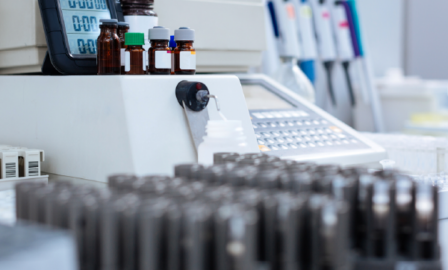Exploring Continuous Pharmaceutical Manufacturing vs. Batch Processing
Batch production has been the industry standard for pharmaceutical manufacturing for over 50 years. Batch processing is straight forward. A new batch cannot begin production until the prior has finished and requires human intervention throughout. However, it is also slow with large amounts of works in progress (WIP) inventory and high potential for human error. This costs the industry approximately $50 billion per year. Though problems exist, batch production is still frequently used because of its low set-up costs and flexibility. It is also optimal for small quantities of unique pharmaceuticals where batching is required due to their composition or formula. Although batch production is common because of these benefits, continuous pharmaceutical manufacturing has entered as a prospective alternative to reduce inefficiencies and increase quality using modern technology.
Continuous Pharmaceutical Manufacturing
The key advantage of continuous manufacturing is that material inputs and outputs can occur simultaneously throughout the process. This means no intermittent pauses or human involvement between the beginning and end. Continuous manufacturing is the standard practice in many other industries, and it is already utilized consistently in over-the-counter (OTC), non-pharmaceutical production. However, continuous manufacturing in pharma is still gaining momentum. Recognizing the benefits of continuous manufacturing for active pharmaceutical ingredient production, Eli Lilly invested in a continuous facility in Ireland. Vertex also currently manufactures their drug Orkambi with the continuous method, and Jannsen has done the same with Prezista. In some cases, pharmaceutical companies are choosing to optimize new drug design specifically for the use of a continuous system. Contract manufacturing organizations are also seeking out opportunities in continuous manufacturing, and partnerships across the supply chain have proven successful for investigating the potential of continuous pharmaceutical production.
The Benefits of Continuous Pharmaceutical Manufacturing
With increasing pressure from the federal government to relieve drug shortages, reduce medical costs for patients, and increase the quality of pharmaceutical products, the FDA has given renewed focus to “Quality by Design” and the use of process-analytical technologies. This led to the FDA’s approval and recommendation of continuous manufacturing, due to the increased speed, quality, safety, and total cost effectiveness of this method.
Costs and Operational Efficiency
Continuous manufacturing can create significant cost savings. Production facilities can operate continuous machinery 24/7 until input materials run out or the lot order quantity is completed. This means that manufacturers can more easily achieve economies of scale, and production time can decrease from weeks or months to just one day, reducing lead times and therefore preventing drug shortages. With very little manual handling, fewer people involved and reduced inventory, lower production costs are achievable. Variable costs can be reduced by 40-50% compared to batch manufacturing for OTC and prescription drugs, which can lower drug prices for patients. This is most beneficial for active pharmaceutical ingredient producers, who can optimize labor costs through shorter processing times. In addition, continuous manufacturing results in less environmental impact compared to other methods of production due to lower energy use and fewer waste products.
Safety and Quality Control
Another major benefit to continuous manufacturing is the increased ability to implement safety and quality controls. Using a reactor with a complex network of pipes, continuous manufacturing can more easily monitor reaction parameters such as concentration, pressure, and temperature. Limiting steps that require human completion also reduces error and improves consistency across lots, lowering the chances of variations. Oversight systems can provide real-time quality assurance, and lot number tracking systems assist companies with mitigating recall issues. This results in a lower likelihood of large-scale scraping of contaminated or ineffective products, while also maximizing throughput. In terms of overall risk mitigation, the increased control of continuous production is helpful in operating with hazardous materials and reducing the conditional fluctuations caused by batch production. Continuous systems can neutralize reactive agents and catalysts immediately, instead of at the end of the batch cycle, lowering the potential for adverse reactions.
While these many benefits of continuous pharmaceutical manufacturing are proving to be highly cost-efficient and quality-improving, the entire industry faces a few challenges that will require early-movers to take some risks to gain the reward.
Organizational and Product-Related Barriers to Implementation
Organizational issues are the main challenge preventing pharmaceutical companies from switching to continuous manufacturing. The mindset of leadership teams must change, since companies are too wary of future issues that may be caused by responsive regulatory barriers resulting from the current lack of comprehensive guidelines. Additionally, continuous manufacturing is still low in use in the pharmaceutical industry, leading to reluctance to be early adopters in case of unforeseen failure. High startup costs, the need for quality-control metrics and lot identification systems to be developed, and overall lack of experience are also preventing companies from switching. Companies must make the decision to invest $4 to $5 million in new equipment for a process that’s success is widely unknown in the pharmaceutical industry. This can appear daunting to some, especially those with a deeply established infrastructure and comfort with the batch methods that have been used for decades. And that’s not all. Even if companies overcome these organizational barriers and the industry begins to more widely accept continuous manufacturing, there may still be challenges in matching production goals to the continuous system.
Other barriers to implementing continuous production are related to the types of products being developed and the machinery used in the process. Not all pharmaceutical companies need or want to produce their drugs at a full-speed, constant level. This means that they are less likely to switch to continuous production, since batching works just fine at a slower pace. Not all products are best fit for a continuous process either. Flow reactor pipes are more effective for some types of APIs than others, since solids can cause blocking and stainless steel is not suitable for corrosive acidic products – and costs of machinery upgrades for this issue are high. Product source purity is also extremely important for continuous production to be effective in quality and safety, and environmental control packaging may be required to optimize rapid production with long-term storing processes. Lastly, obtaining an acceptable return on investment for machinery costs may be difficult for some companies to achieve, since the equipment for continuous manufacturing is much more expensive than machinery used in batch production. Only one production project can be used with continuous machinery at a time, meaning that after completion, complex parts must be cleaned thoroughly, leading to long turnaround times. This also means that since machinery is limited to one project, that drug must be highly demanded and sell well for cost optimization.
Pharmaceutical companies should consider the benefits and challenges with adopting continuous manufacturing to decide if they can implement it successfully. Creating products with robust and scalable chemistry, possessing a systematic process design and effective process analytical technology, and utilizing a skilled team with established partnerships to mitigate cost risks can help an effective transition to continuous manufacturing. With the growth of fast-tracked drug production with reduced clinical development paths to FDA approval along with FDA encouragement, continuous manufacturing can become the new normal for pharmaceutical companies. Both generics companies and brand name pharma can benefit from reduced costs of goods sold and higher profit margins, making the decision to shift to continuous production only a matter of time.
Subscribe to Clarkston's Insights
Contributions by Courtney Loughran.



